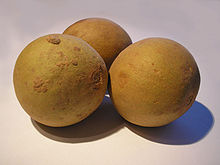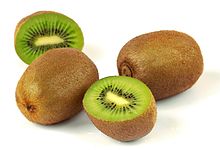The
potato is a
starchy,
tuberous crop from the
perennial Solanum tuberosum of the
Solanaceae family (also known as the nightshades). The word potato may refer to the plant itself as well as the edible tuber. In the region of the
Andes, there are some other closely related cultivated potato species. Potatoes were first introduced outside the Andes region four centuries ago, and have become an integral part of much of the world's cuisine. It is the world's fourth-largest food crop, following
rice,
wheat, and
maize.
[1] Long-term storage of potatoes requires specialised care in cold warehouses.
[2]
Wild potato species occur throughout
the Americas, from the United States to
Uruguay.
[3] The potato was originally believed to have been domesticated independently in multiple locations,
[4] but later genetic testing of the wide variety of
cultivars and wild species proved a single origin for potatoes in the area of present-day southern
Peru (from a species in the
Solanum brevicaule complex), where they were domesticated 7,000–10,000 years ago.
[5][6][7] Following centuries of
selective breeding, there are now over a thousand different types of potatoes.
[6] Of these
subspecies, a variety that at one point grew in the
Chiloé Archipelago (the potato's south-central
Chilean sub-center of origin) left its
germplasm on over 99% of the cultivated potatoes worldwide.
[8][9]
Following the
Spanish conquest of the
Inca Empire, the Spanish introduced the potato to Europe in the second half of the 16th century. The staple was subsequently conveyed by European mariners to territories and ports throughout the world. The potato was slow to be adopted by distrustful European farmers, but soon enough it became an important food staple and field crop that played a major role in the European 19th century population boom.
[7] However, lack of genetic diversity, due to the very limited number of varieties initially introduced, left the crop vulnerable to disease. In 1845, a plant disease known as late blight, caused by the fungus-like
oomycete Phytophthora infestans, spread rapidly through the poorer communities of western Ireland, resulting in the crop failures that led to the
Great Irish Famine. Nonetheless, thousands of varieties persist in the Andes, where over 100 cultivars might be found in a single valley, and a dozen or more might be maintained by a single agricultural household.
[10]
The annual diet of an average global citizen in the first decade of the 21st century included about 33 kg (73 lb) of potato. However, the local importance of potato is extremely variable and rapidly changing. It remains an essential crop in Europe (especially eastern and central Europe), where per capita production is still the highest in the world, but the most rapid expansion over the past few decades has occurred in southern and eastern Asia. China is now the world's largest potato-producing country, and nearly a third of the world's potatoes are harvested in China and India.
[11]









